
back to The Art of Alchemy index

This article is also available in PDF format.
|
The Alchemical Door is a nice example of art in alchemy. It was ordered by a marquis, to be part of his villa. Aside from its unique approach to decorate a doorway with alchemical symbols, it also provide us with a rich example of alchemical information and advice. The marquis probably had these doorways made this way to attract an mystic aura to his villa and thus to himself, in an era when alchemy was popular. The villa became his preferred meeting place with the foremost scholars of the period.
The Alchemical Door, known in Italy at Porta Alchemica, is a stone door frame from the 17th century, that once was part of the villa Palombara, located on the Esquiline hill, near Piazza Vittorio, in Rome. The villa was the residence of Massimiliano Palombara (1614-1680), Marquis of Pietraforte. There were four more such doorways in the villa, but all four have gone. The marquis Palombara, a poet, and Rosicrucian, developed a passion for alchemy in 1656, when he visited the alchemical laboratory in Riario Palace, now known as Palazzo Corsini, the residence of the exiled queen Christina of Sweden, who had a court in Rome. It was rumored that she had an alchemical laboratory, and it is said that the gate was built to memorialize a successful alchemical transmutation that occurred in the Riario Palace. The marquis also had a large library of alchemical books. The villa was destroyed in the nineteenth century to make room for the new neighborhood under construction, and a while later, in 1888, the doorway was moved to a nearby park, and set into a remaining wall of a church. Two statues of the Egyptian god Bes, were found in the ruins of a nearby Roman temple of Isis and Serapis, and were placed next to the doorway, also in 1888. It has been suggested that the Alchemical Gate was part of the villa itself, and not of the surrounding wall. If the latter had been the case, it would have been visible to all people, and because all the symbols and text were hermetic/alchemical, he would have been in much trouble with the authorities and Church. |
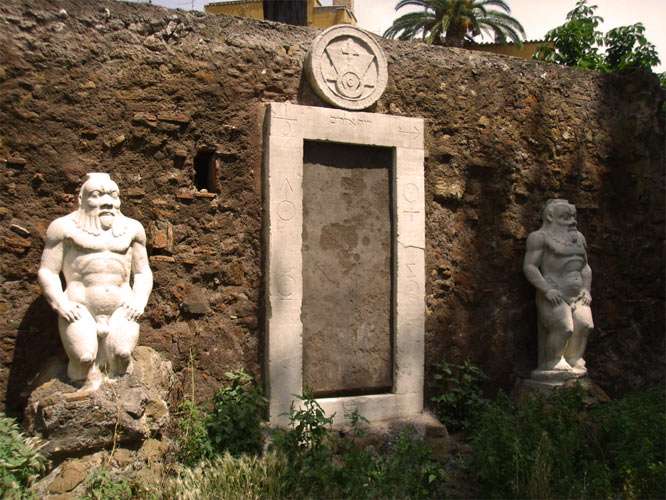
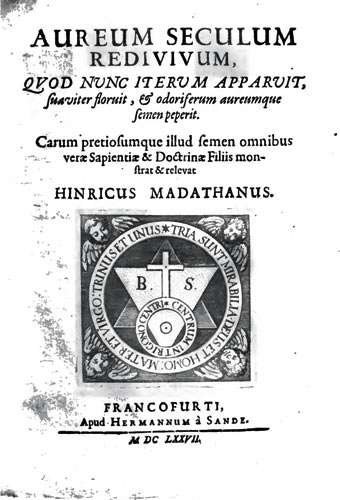
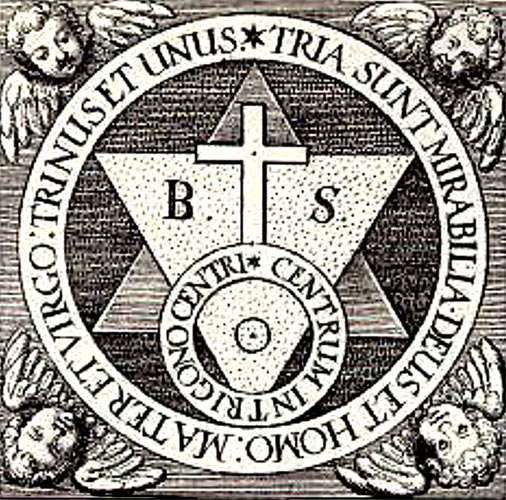
|
The top part, or pediment of the gate, shows four angels surrounding a circle, containing two overlapping triangles and a cross on a smaller circle that contains the sun/gold symbol ☉. The marquis was familiar with the publication of the second edition of the (Latin) alchemical book Aureum Saeculum Redivivum, (1621) by Adrian von Mynsicht (known also as Madathanus) (1603–1638), as the emblem is a reproduction of its front cover (see above images). The overlapping triangles, forming a Solomon's seal, is a well-known symbol for the inseparable dual aspects of Sun and moon, Mercury and Sulfur, male and female etc. In the publications I have read, nobody seems to notice that the cross on the circle is the alchemical symbol for Antimony 🜱. Dom Pernety in his Dictionaire Mytho-Hermetique gives the following explanation for Antimony, in the spiritual sense: "The thing that Philosophers give the name of antimony is their permanent water, their celestial water, in a word, their mercury; because this cleanses, purifies and washes the gold philosophical, like common antimony purifies common gold." Placing the sun ☉ inside the circle of the symbol for Antimony, refers to the seed in the center: "Seed: Mercury of the Philosophers, principle and seed of all metals, without being metal itself currently, but only in power." (Dom Pernety) The emblem of Aureum Saeculum Redivivum also contains the letters B. and S., but they are not present on the Alchemical Door. The text in the outer circle reads: TRIA SUNT MIRABILIA DEUS ET HOMO MATER ET VIRGO TRINUS ET UNUS (There are three marvels: God and man, mother and virgin, threefold and one.) Trinity is a well-known concept in alchemy. It is primarily rooted in hermetic wisdom, and religious beliefs, but can be interpreted in many ways. The text in the inner circle reads: CENTRUM IN TRIGONO CENTRI (The center is in the triangle of the center). A more cryptic statement, but in alchemical language it refers to the Center of the World: "Center of the world. It is the material of Philosopher's Stone, and the stone even when it is in its perfection. The Philosophers have it so named, because they say that all properties of the Universe are there together." (Dom Pernety) |
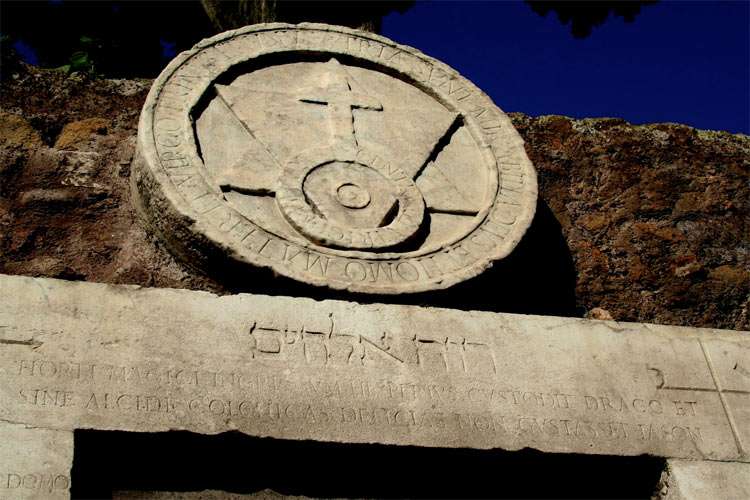
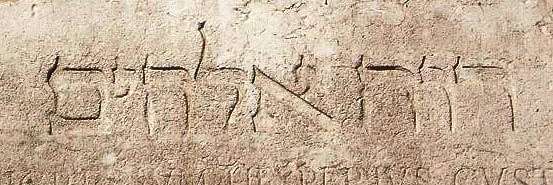
|
The Hebrew line on the architrave reads: רוח אלהי, Ruach Elohim (the Spirit of God). This term is used as a Divine blessing of power and direction. It is Elohim that is directing you. In alchemy, we often find a reference to seeking the blessing of God. Sometimes it is claimed that one needs the grace of God to succeed in his alchemical work. Underneath is the text: HORTI MAGICI INGRESSUM HESPERIUS CUSTODIT DRACO ET SINE ALCIDE COLCHICAS DELICIAS NON GUSTASSET IASON (A dragon guards the entrance of the magic garden of the Hesperides, and, without Hercules, Jason would not have tasted the delights of Colchis.) This is an unusual combination of two ancient myths: the garden of the Hesperides and the travels of the Argonauts to obtain the Golden Fleece. The hermetic alchemists often used mythological stories to explain the spiritual quest. The alchemists identified the Golden Fleece with the philosopher's stone. The dragon is the lower emotions that need to be slain. The garden of the Hesperides is one's own self. Hercules refers to the fact that it takes great strength to walk the spiritual path and be successful. It has been suggested that the marquis considered his entire villa as the garden of the Hesperides, where they could conquer the Golden Fleece, that is, to start to path of self-perfection that would eventually leading to the philosophical gold, symbolized by the above sun ☉ sign. |
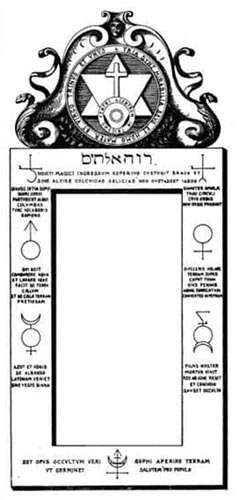
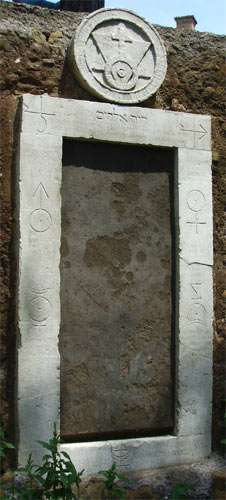
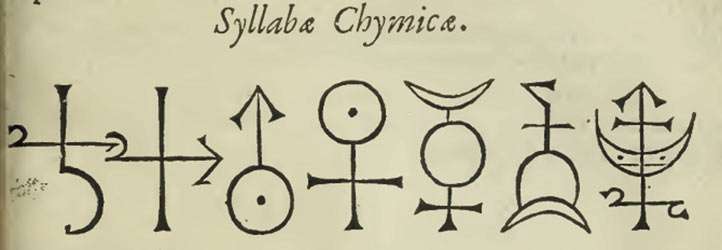
The sigils in Commentatio de pharmaco catholico
|
There are six sigils on the left and right side of the doorframe, and one on the bottom. They are 'Chemical Syllables' taken from the subtext Commentatio de pharmaco catholico, on page 360 of Reconditorium ac reclusorium opulentiae sapientiaeque numinis mundi magni, cui deditur in titulum Chymica Vannus, 1666, by Johannes de Monte-Snyder. The seven 'syllables' in this work are displayed in a row under the heading Syllaba Chymica. This very important alchemical work was translated from the original Latin language into the Italian language by Girolamo Moggia and Vinci Verginelli during the period 1921-1925. This translation (the original manuscript is at the Biblioteca of the "Accademia Nazionale dei Lincei", and belongs to the famous collection of ancient hermetical books donated by Vinci Verginelli in 1984, and of which he wrote a Catalogue entitled "Bibliotheca Hermetica...", edited by Bruno Nardini, Firenze, 1986)was edited just in 1999 by the IBIS Editions. This book is a masterpiece of hermetic wisdom according to the highest Rosicrucian tradition.
Before the sigils, The Commentatio de pharmaco catholico gives a list of A Simple Alphabet of the seven metals. There are the astrological signs of the planets, followed by their corresponding metal, and alchemical symbols that go with it: ♄ Lead, also called black Wolf; death and Gold ♃ Tin, sometimes sublimated Mercury; which is to be understood as Sal ammoniac ♂ Iron ☉ Gold, King, Red lion & Dragon ♀ Copper, green Woman, green Lion ☿ Quicksilver, Mercury, Serpent-bearer, Tilbon, Hermes or messenger of the gods, Snake, volatile Salt; The swan is called the bath by which the Queen purifies herself. ☾ Moon, Silver has Saturn's weapons by reason of quality
Under the heading Syllaba Chymica that follows, the writer explains that alchemists use these seven planetary symbols to construct new 'syllables' that can have additional meanings. The seven syllables portrayed in that chapter are just examples of how one can go about it. They are just examples, and although at least five of them resembles planetary signs, they do not have specific meanings. Nevertheless, Susanna Åkerman sees the seven syllables, reproduced on the Alchemical Door, as symbols for the seven planets, a view that everyone seems to take for granted. Personally, I think The marquis put these 'syllables' on the doorframe, just to make it look mysterious. Having read the Commentatio de pharmaco catholico, he knew that they were just examples of constructing new alchemical signs, because the text that goes with the syllables tells us: "It is not my intention to discourse on sublime matters here, but on the alphabet, from which one may see syllables and then words may be formed. This alphabet consists of simple characters, syllables of course their combination, where certain characters are contracted into one, these syllables go on into words, and these give sense or meaning; they unfold the nature and property of the designated and figured things: what therefore we can make from any particular thing, and also what it was before in terms of virtue" (done fast, and not too inaccurately, I hope)." The text that goes with the syllables on the door frame are alchemical references, but they have no relation to any planet, nor with the syllables.
The text with each sigil is: Lead: QUANDO IN TUA DOMO NIGRI CORVI PARTURIENT ALBAS COLUMBAS TUNC VOCABERIS SAPIENS; When in your house black ravens give birth to white doves, then will you be called wise. Tin: DIAMETER SPHAERAE THAU CIRCULI CRUX ORBIS NON ORBIS PROSUNT; The diameter of the sphere, the tau in the circle, and the cross of the globe bring no joy to the blind. Iron: QUI SCIT COMBURERE AQUA ET LAVARE IGNE FACIT DE TERRA CAELUM ET DE CAELO TERRAM PRETIOSAM; He who can burn with water and wash with fire makes a heaven of earth and a precious earth of heaven. Copper: SI FECERIS VOLARE TERRAM SUPER CAPUT TUUM EIUS PENNIS AQUAS TORRENTUM CONVERTES IN PETRAM; If you make the earth fly over your head, with its wings you may convert torrential waters to stone.” Mercury: AZOTH ET IGNIS DEALBANDO LATONAM VENIET SINE VESTE DIANA; When azoth and fire whiten Latona, Diana comes unclothed. Antimony: FILIUS NOSTER MORTUS VIVIT REX AB IGNE REDIT ET CONIUGO GAUDET OCCULTO; Our dead son lives, returns from the fire a king, and enjoys occult conjugation.
On the base is another sigil, with the text: EST OPUS OCCULTUM VERI SOPHI APERIRE TERRAM UT GERMINET SALUTEM PRO POPULO; It is a secret work of true wisdom to open the earth, so that it may generate salvation for the people. |
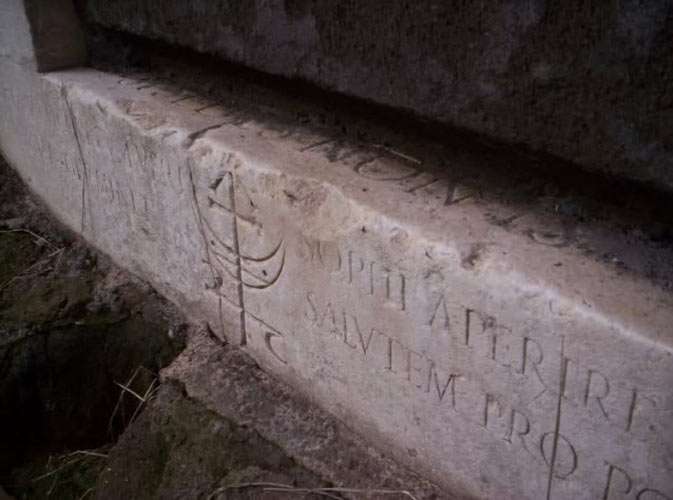
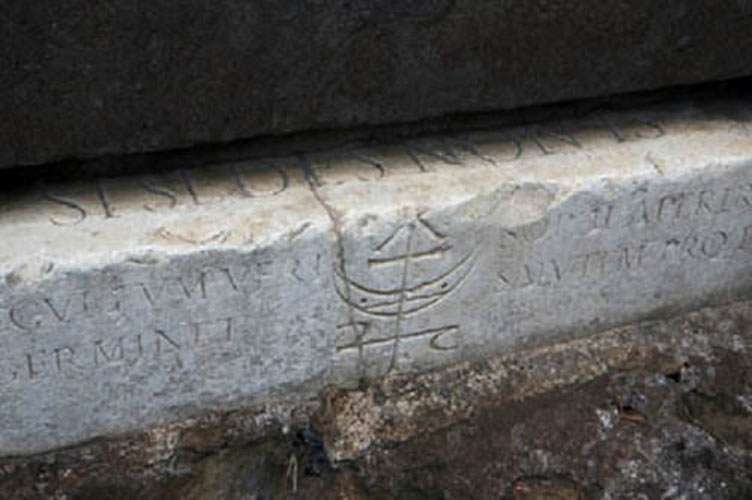
|
Above it, on the doorstep, where you place your foot to go inside is the text: SI SEDES NON IS. This can be read from left to right, or from right to left; so it means: "If you sit, you do not go" and "If you do not sit, you go." |
Etching by Francesco Girolamo Cancellieri, 1806
click on image to enlarge
|
In 1802, an Italian writer, Francesco Girolamo Cancellieri, wrote another fanciful legend about the Alchemical Door. He claimed to also have marquis Massimiliano Palombara's entire collection of inscriptions. He mentioned some other engraved inscriptions in the villa that were lost when the villa was destroyed. Here they are: VILLAE IANUAM TRANANDO RECLUDENS IÀSON OBTINET LOCUPLES VELLUS MEDEAE 1680 Walking through the opening the door of the villa, Jason obtained the rich fleece of Medea 1680. AQUA A QUA HORTI IRRIGANTUR NON EST AQUA A QUA HORTI ALUNTUR The water irrigating these gardens is not the water feeding them. CUM SOLO SOPHORUM LAPIS NON SALE ET DATUR SOLE SILE LUPIS Be content with just the salt of knowledge and the sun of reason. QUI POTENTI HODIE PECUNIA NATURAE ARCANA EMITUR SPURIA REVELAT NOBILITAS SED MORTEM NON LEGITIMA QUAERIT SAPIENTIA He who reveals the mysteries of nature to an influential person is looking for his own death. HOC IN RUBE, CAELI RORE, FUSIS AEQUIS, PHYSIS AQUIS, SOLUM FRACTUM, REDDIT FRUCTUM, DUM CUM SALE NITRI, AC SOLE, SURGUNT FUMI SPARSI FIMI. ISTUD NEMUS, PARVUS NUMUS, TENET FORMA SEMPER FIRMA, DUM SUNT ORTAE SINE ARTE VITES, PYRA, ET POMA PURA. HABENS LACUM, PROPE, LUCUM, UBI LUPUS NON, SED LUPUS SEPE LUDIT; DUM NON LAEDIT MITES OVES, ATQUE AVES; CANIS CUSTOS INTER CASTOS AGNOS FERAS MITTIT FORAS, ET EST AEGRI HUJUS AGRI AER SOLUS VERA SALUS, REPLENS HERBIS VIAS URBIS. SULCI SATI DANT PRO SITI SCYPHOS VINI. INTROVENI, VIR NON VANUS. EXTRA VENUS. VOBIS, FURES, CLANDO FORES. LABE LOTUS, BIBAS LAETUS MERI MARE, BACCHI MORE. INTER UVAS, Sl VIS, OVAS, ET QUOD CUPIS, GRATIS CAPIS. TIBI PARO, CORDE PURO, QUICQUID PUTAS, A ME PETAS. DANT HIC APES CLARAS OPES DULCIS MELLIS, SEMPER MOLLIS. HIC IN SILVAE UMBRA SALVE TU, QUI LUGES, NUNC SI LEGES NOTAS ISTAS, STANS HIC AESTAS, VERA MISTA; FRONTE MOESTA NUNQUAM FLERES, INTER FLORES SI MANERES, NEC MANARES INTER FLETUS, DUM HIC FLATUS AURAE SPIRANT, UNDE SPERANT MESTAE MENTES INTER MONTES, INTER COLLES, INTER GALLES, ET IN VALLE HUJUS VILLAE, UBI VALLUS CLAUDIT VELLUS. BONUM OMEN, SEMPER AMEN ETIAM PETRAE DUM A PUTRE SURGUNT PATRE, ITA NOTAS, HIC VIX NATUS, IN HAC PORTA, LUTO PARTA, TEMPUS RIDET, BREVI RODET. In this villa, from heavenly dew, tilled fields and running waters, the furrowed soil fruit gives; in the meanwhile, in saltpeter and because of the sun, from the dispersed manure vapors rise. This small forest always looks the same; while spontaneously vine shoots, sincere pear and apple trees are born. Near the lake there is a small forest where who plays is not the wolf, but the hare; it jokes without offending the meek sheep and the birds. The dog guarding the chaste lambs chases predators away; and the countryside air is enough to give health back to the sick. This estate fills with produce the city's streets. The plowed furrows give cups of wine for your thirst. Modest man, enter! May Venus stay away! To you, thieves, I close my doors. Drink merrily and copiously pure wine, as if you were Bacchus himself. Rejoice among the vines, and take freely whatever you may desire. For you I sincerely prepare what you ask for. Here bees produce in great amounts sweet, soft honey. Cheers to you, who are crying in the shadow of these trees. Now, if you understood this, that here summer mixes with spring, you would not be crying with so much sadness. If you remained here, among the flowers, you would not cry, because here you can breathe the fragrance of air. Therefore, the melancholic souls recover and learn to hope once again among the mountains, the hills, the paths and in the valley of this villa, where the sheepfold protects the flock. For you I make a wish: may it always be thusly. |